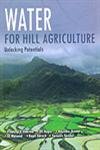Pradeep Kumar Sharma Kapur Rajinder (2 results)
Product Type
- All Product Types
- Books (2)
- Magazines & Periodicals
- Comics
- Sheet Music
- Art, Prints & Posters
- Photographs
- Maps
-
Manuscripts &
Paper Collectibles
Condition
Binding
- All Bindings
- Hardcover (1)
- Softcover
Collectible Attributes
- First Edition
- Signed
- Dust Jacket
- Seller-Supplied Images
- Not Printed On Demand
Seller Location
Seller Rating
-
Water for Hill Agriculture Unlocking Potentials
Published by Westville Publishing House, New Delhi, 2010
ISBN 10: 8185873577ISBN 13: 9788185873572
Seller: Books in my Basket, New Delhi, India
Book
Hardcover. Condition: New. 158pp.
-
Water for Hill Agriculture : Unlocking Potentials
Published by Westville Publishing House, 2010
Seller: Vedams eBooks (P) Ltd, New Delhi, India
14 colour plates, 22 b/w plates, tables, figs, map (illustrator). Contents Foreword Preface 1 Water Resources in Hills 2 Rainwater Harvesting 3 Traditional Irrigation System The Kuhl Irrigation 4 Irrigation Management 5 Managing Soil Moisture for Better Yields 6 Watershed Development 7 Technological Innovations A summary 8 Water Management Strategies for Hilly Areas 9 Publications 10 Subject Index The entire agriculture production system is based on how efficiently the natural resources are utilized therefore soil and water play the most critical role in this process India has the onus of feeding 17 of worlds human and 11 of the livestock population on 4 of the water resources and 23 of the land It is also a harsh fact that the availability of these two precious resources is reducing each passing day On one hand the net cultivated area has hovered around 1402 million has since 1970 ie for almost 4 decades with very little scope of area expansion On the other hand it is estimated that a minimum of 400 million tonnes of food production annually would be the required to feed a population likely to cross 15 billion by 2050 Obviously the natural resources are going to be put under enormous strain as there is not alternative to intensification of agricultural activities to ensure food security Although the annual long term average rainfall of India is 117 cms compared to the global average of 110 cms it is highly erratic in its spatial and temporal distribution The uncertainty of rainfall is going to increase further as a consequence of global warming worsening the situation in rainfed regions in particular Of the total precipitation that falls in the country less than 29 is harvested or utilized and 21 of it is lost to the sea It is also the hill eco-system which is associated with higher rainfall This is the reason why soil erosion rates are very high in this eco-system For example in the state of Himachal Pradesh more than 30 ie almost one third of the geographical area has soil erosion rates of more than 10 tha year This not only results in the loss of soil but also nutrients It is estimated that at the national level 53 billion tonnes of soil and 6 million tonnes of nutrients are lost resulting in an economic loss in production of more than Rs11000 crores The All India Coordinated Research Project on Water Management which was established in Karnal in 1969 also has the specific mandate of developing and generating technologies related to water management in high rainfall areas The centre at CSK Himachal Pradesh Agriculture University Palampur which was started in 1972 has been contributing very significantly on these aspects Since water is going to occupy centre stage locally nationally and internationally both in the short term and long term it is imperative that this precious resource is managed efficiently and effectively in a sustained manner The initiative taken by the scientists working at the Centre in compiling this publication on all issues related to water management for the hill region entitled Water for Hill Agriculture Unlocking Potentials is a very timely publication In this single compilation the authors have looked at all aspects of water management be it irrigated or rainfed agriculture The introductory chapter has documented the water resources of the region Another chapter highlights the traditional Khul irrigation and ways and means of enhancing water efficiency Rainwater harvesting which is so essential for sustaining the productivity and enhancing cropping intensity has been dealt with comprehensively along with watershed development Irrigation water use efficiencies are generally very low and an improvement in their efficiencies through the interventions developed by the Centre will go a long way in sustaining this finite resource I compliment the authors for making sincere efforts and I am confident that this publication will be useful not only to water managers but also to the scientists stakeholders state officials administrators as well as students 148 pp.



